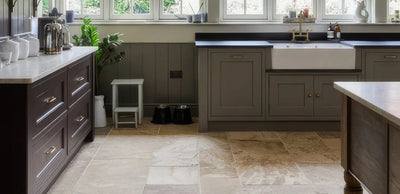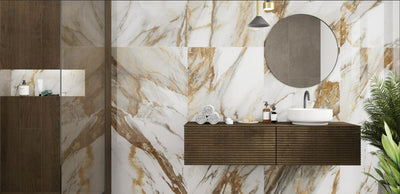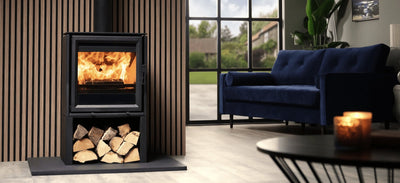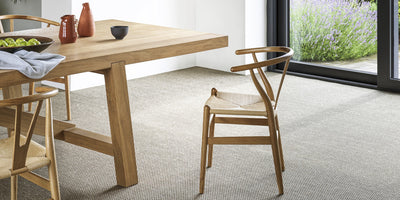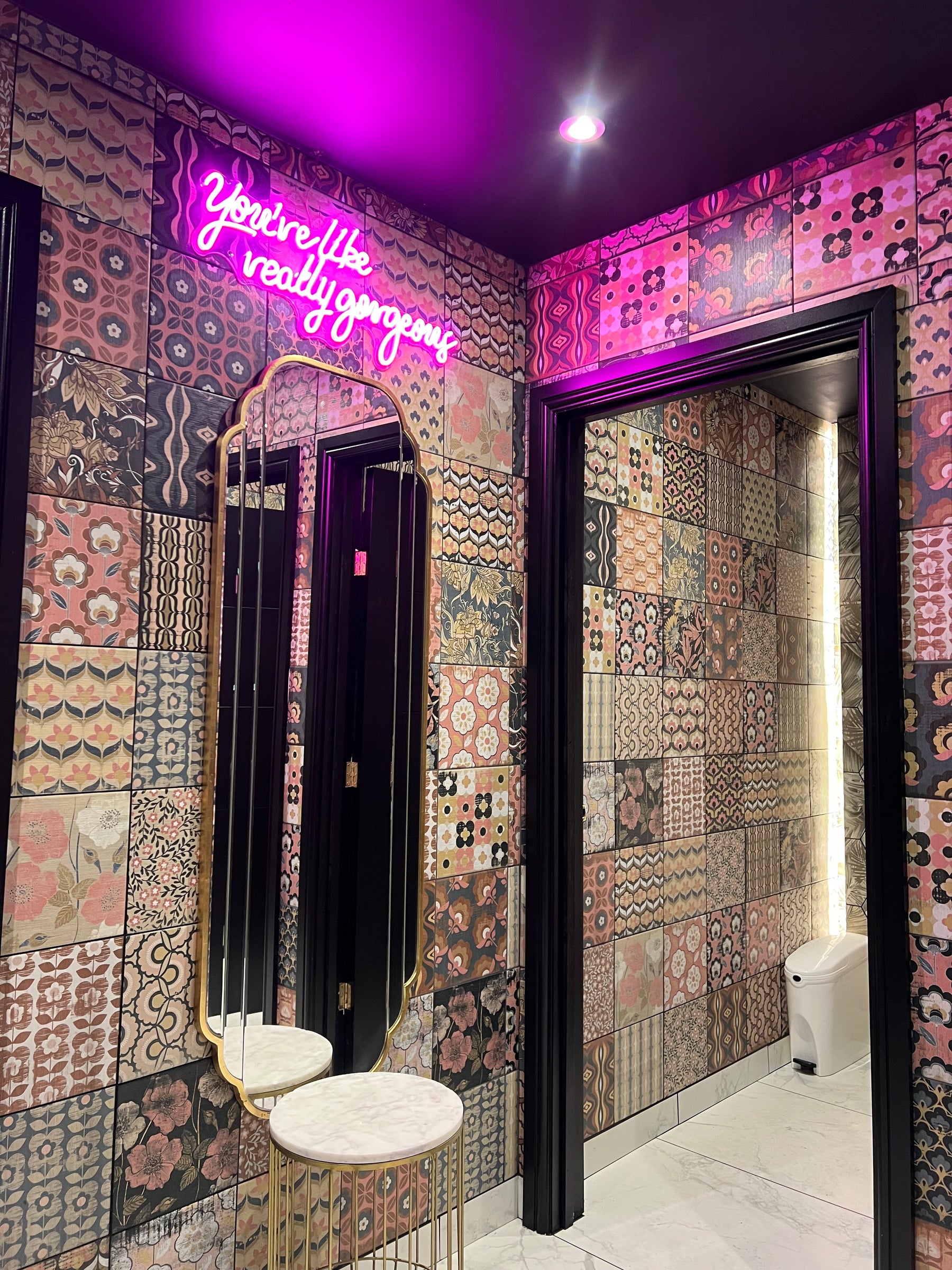
Soju by Sumo - Restaurant Project
In the heart of Beverley, East Yorkshire you can find the recently opened ‘Luxury Asian Tapas’ restaurant known as ‘SOJU by Sumo’, curated by Gary Chin, owner of Sumo Pan Asian and the 2022 winner of BBC Two’s ‘Britain’s Best Takeaway’ award. SOJU by Sumo delivers high quality food in style, so obviously, they needed the interior to match.
When initially discussing plans with Gary and Desmond, the two owners, it became clear that we were going to be stepping far away from the ‘minimalist’ theme that seems to be predominant in many restaurants at the moment. The initial challenge presented by this choice was that we were going to have to find decorative and patterned tiles that could be blended cohesively together to create a consistent theme throughout the restaurant.
Starting from the entrance and working backwards, the entrance hall/area was approximately 50m2, and a somewhat irregular shape, as it would go on to contain both the wine storage and a table for a larger group, as well as the seating area in which people could have pre-meal drinks and wait for their tables. Several options were discussed for this area, such as our ‘TAPESTRY’ small format porcelain tiles which are a black and white ornate pattern in a 25 x 25 (cm) size (see image below). As well as our ‘VINTAGE’ Hex tiles which combine shades of black, white, and grey in a variety of traditional and contemporary patterns (see images below).


However, we eventually came to the conclusion that whilst a small format decorative tile with dark colour’s seemed to fit the bill, we were lacking something, texture. The answer to our problem arrived in the form of our ‘CASTAWAY’ small format hexagonal tiles. Castaway is a wooden effect tile that ranges largely in colour, containing shades of dark blue, grey, black, light and dark brown, and everything in-between to create a unique, yet natural aesthetic, emphasized by the wood grain effect.
As you can see in the image below, the variety of shades found within Castaway becomes even more pronounced when applied over large areas, providing greater scope for the differentiation to become more pronounced. The cocktail of shades helps to create a nice ambience at the entrance of the restaurant, providing a degree of intrigue without being too overwhelming and detracting from other aspects of the restaurant.




We repeated the Castaway once again up the stairs and in the hallway leading to the private group dining room, and we have to say the results were truly excellent, the small format of these Porcelain tiles made them effective for the tilers to work with in tight spaces, and the variety of dark tones produced a discreet, stylish aesthetic.

Moving on to the next, and possibly most important section of any restaurant is the primary dining area, as this is where customers will spend 90% of their time during any visit to a restaurant, essentially meaning it’s a very important part to get right!
When considering options for the primary dining area we had to three main factors into consideration, these being:
- Does the tile have adequate non-slip properties?
- Can we find a cost-effective option for such a large area?
- Can we find an option that contains some character of its own, whilst serving primarily to elevate the furnishings situated on and around the tiles?
NON-SLIP
This is potentially the most important factor of the three, as it correlates heavily with health and safety regulations, which are crucial in any business environment, as failure to comply can lead to a variety of legal issues, which as anyone could guess is not ideal for a new business!
The two owners of SOJU made it clear from the start that they were interested in having a marble look of some description, however it became clear very quickly that a polished marble tile or polished marble effect porcelain tile was out of the question. The reason for this being that since the tiles are going to be situated in the primary dining area, there is a high chance that food or drink will be spilled onto the tiles at some point, and a polished surface when compromised with any sort of fluid can become a slip hazard, which would present issues for both staff and customers of the restaurant.
From this discussion we decided to go for a tile with a matt finish for its more tactile and grippy surface in comparison to a polished surface, and furthermore, decided to choose a porcelain marble effect tile with a matt finish as opposed to a natural Marble tile. As taking into consideration the earlier point of it being likely that food and drink will be spilled on the tiles at some point, porcelain’s non-porous properties will make it easier to clean and maintain.
COSTINGS AND EFFICIENCY
As the primary dining area of the restaurant is a large area, it was essential to both us and the customer that we tried to achieve the best results whilst being conscious of the price per m2.
This led us to the conclusion that it would probably be more cost effective to go with a porcelain marble effect tile, rather than a natural marble stone tile. There are several reasons for this choice, with the main reason being the most obvious; generally, porcelain tiles are cheaper than natural stone options, particularly in the case of Marble. However, this is by no means always the case.
Furthermore, another aspect that must be considered when looking at the delivery and installation of any tiles is the percentage of damage sustained either in transit or during installation. Now obviously, this percentage/ratio cannot be defined as an exact science (although we usually estimate 10-15% to be on the safe side) but certain materials are more prone to being damaged. For example, Marble tiles are notorious for being somewhat brittle, which can increase the likelihood of them being damaged, whereas Porcelain tiles are manufactured to have a small degree of give in them, meaning they are moderately less susceptible to being damaged.
From the perspective of efficiency, another element to consider was the time it would take to install the tiles, as the restaurant was scheduled to open on a specific date and there was still an adequate amount of construction that needed to be completed as well as the flooring that we were providing. Therefore, when making the selection of what tiles we were going to use for the main dining area we had to take the size of the tiles into consideration, as different size tiles take longer/shorter amounts of time for the tiler to install. Porcelain tiles are widely available in a broad range of sizes depending on the style/finish, meaning there are generally more size options for Marble effect Porcelain tiles then Natural Marble Tiles. As natural Marble tiles are commonly cut in smaller sizes such as 60x40 (cm) when they are only 10mm thick, as when they are cut in larger sizes, they become weaker and more likely to sustain damage. Since the area is a large one, we opted to go with 75x75 (cm) porcelain tiles, as this size allows a large amount of surface area to be covered per tile, without the tile being so big/heavy that it makes it difficult for the tiler to handle. It was also noteworthy with this project that by using larger format tiles less joints are required, so the amount of time spent grouting will be reduced.
STYLING
The owners of SOJU have invested large amounts of both time and money into perfecting and refining the interior styling of their restaurant, with extensive design features spanning even across the ceiling of the restaurant. Therefore, when assisting and recommending a selection for the floor tiles of the primary dining area, we wanted something that would fit their vision, and compliment the other interior aspects that were planned. As previously discussed, the owners were keen to achieve a marble look with the flooring, however, all parties involved felt that the only viable option for a marble look would be a darker marble, in shades of grey and black. The primary reason for this being that a white marble, or paler colour in general may detract from the type of ambience that the owners were looking to create.
This lead us to reach the conclusion that our ‘MARQUINA’ marble effect porcelain tiles in a matt finish would be the best choice for the primary dining area. An understated, sleek, choice, with adequate non-slip properties, and coming at a moderate price point. Marquina ticked all the boxes in this case, and we couldn’t be happier with how it turned out!
I 
Now everyone knows that in this day and age that social media presence plays a role for almost all businesses. Restaurants are no exception to this, and a good setting for a picture or selfie can be the catalyst that drives people to visit, before even taking into consideration the food or drink on offer.
So this got us thinking for the bathroom, we had to go big or go home!
For the area surrounding the mirror in the women’s bathroom we used a favourite of ours we call ‘CERISE’! Cerise is a 25 x 25 (cm) decorative porcelain tile that combines a variety of patterns and designs in a summery spectrum of colours, centred around a primarily pinkish hue.
We love the utilization of Cerise behind the backlit mirror in this bathroom! The setting really enhances the vibrance and diversity of the colour’s and patterning!


For the stalls we sourced a special item that is generally not held in stock, we call this product ‘VEGETAL’, as you can see below Vegetal is a small format decorative tile in a 25 x 25 (cm) size, although it is also available in a HEX size as well. The Vegetal fitted in perfectly with the use of bold and striking colour palettes throughout the restaurant, as the sharp whites and piercing greens really stand out, and help to elevate the inside of the cubicles, which are generally considered to be a less design-focused area. These Vegetal tiles were applied to the walls of both the men’s bathroom and sections of the women’s bathroom – As seen in the below images!
The second aspect we had to consider in the bathrooms was the flooring tiles. Like the primary dining area flooring, we had to ensure that the non-slip element was taken into consideration, meaning once again we had to go with a tile that had a matt finish. Ideally, we wanted to ensure that the bathrooms would be thematically aligned with the rest of the restaurant (within reason of course), whilst also considering the different requirements of a bathroom in comparison to other areas of the building. Our resolution to this was to select our ‘EIGER’ marble effect porcelain tiles with a matt surface, as the patterning’s are comparable. However, whereas the ‘MARQUINA’ we used in the primary dining area is black/grey with white markings, Eiger is predominantly white with minor black/grey markings. We saw this as the logical choice for the bathroom floors as from a health and safety point of view it is important that the bathroom is well-lit, bright, and safe to navigate, and the white found in Eiger is obviously a much brighter colour than the thunder greys and black found in Marquina.
To conclude this post, we really enjoyed being involved in this project, as it gave us an opportunity to work with a great variety of alternate styling options that would normally be included under one roof in a residential property. It has been a real pleasure to watch Soju rapidly become a favourite spot among the residents of Beverley and we can only hope this success continues, as we would be delighted to collaborate once again in the future!

